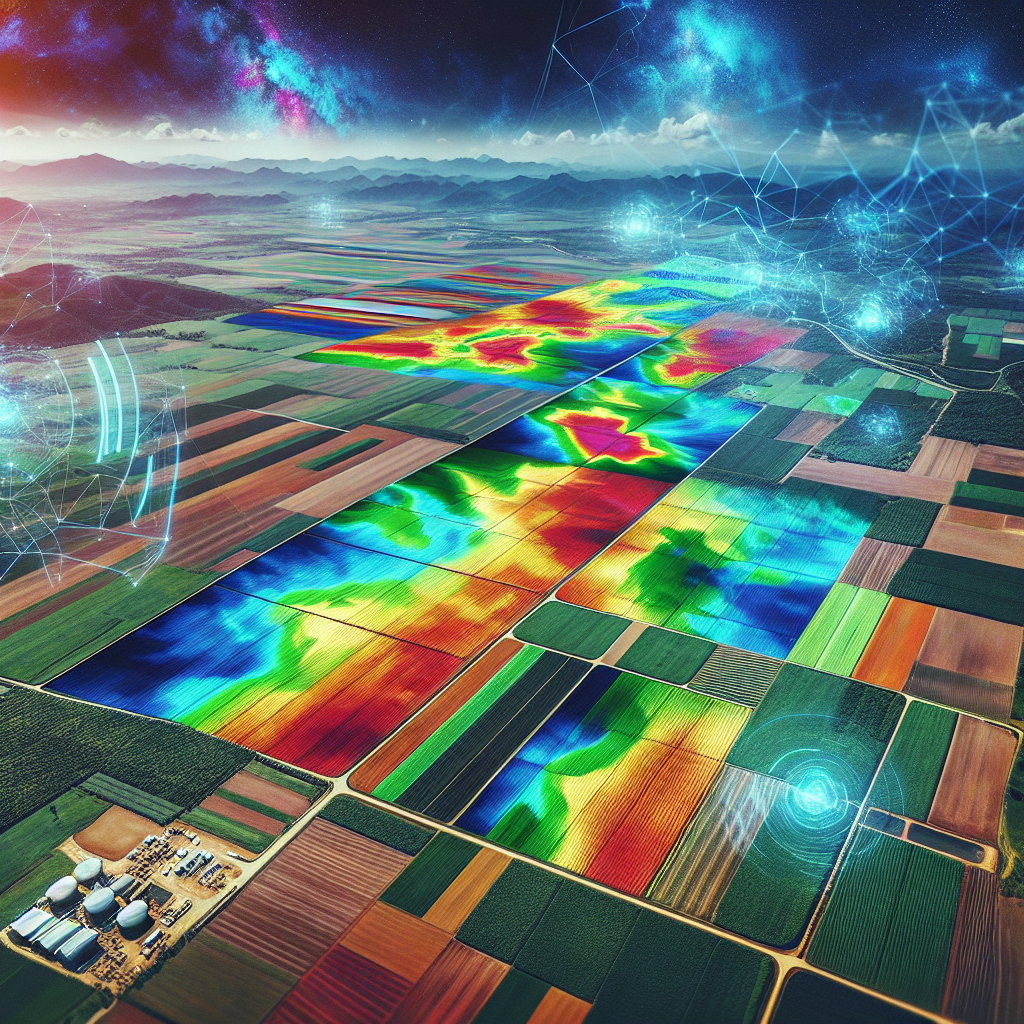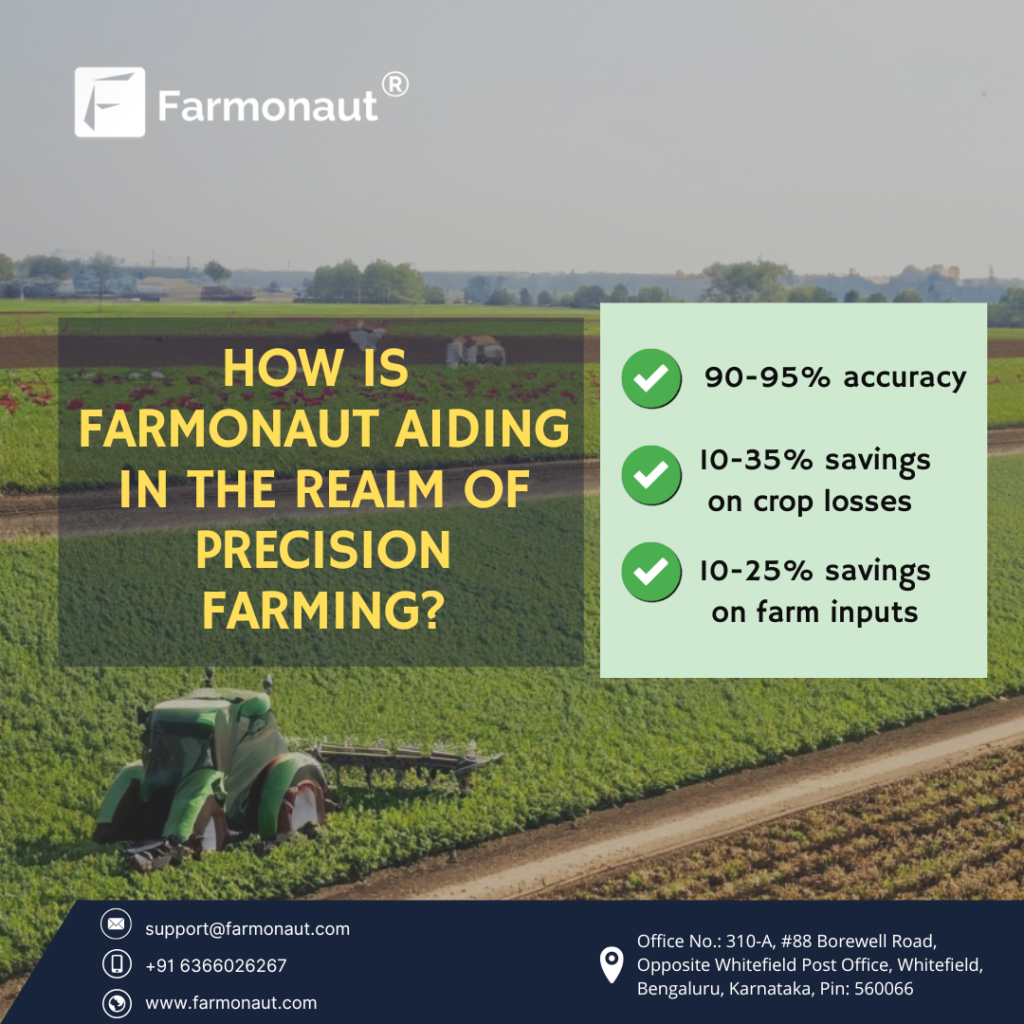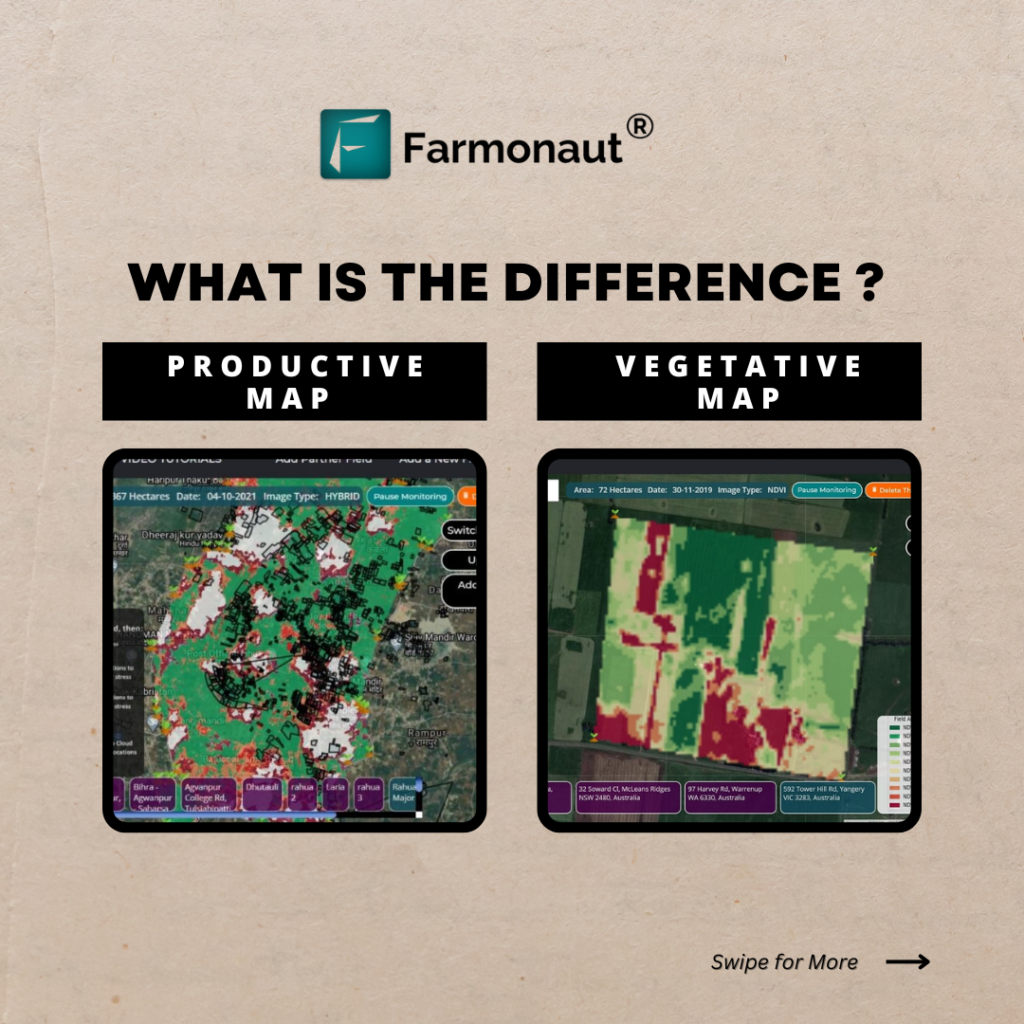Maximize Your Harvest: Ultimate Guide to Grain, Vegetable, and Crop Yield Calculators

In the ever-evolving world of agriculture, precision and efficiency are key to maximizing yields and ensuring sustainable farming practices. At Farmonaut, we understand the critical role that accurate yield estimation plays in modern agriculture. That’s why we’ve created this comprehensive guide to grain yield calculators, harvest yield calculators, and vegetable yield calculators. These powerful tools can help farmers, agronomists, and agricultural professionals make informed decisions and optimize their crop production.
1. Introduction to Yield Calculators
Yield calculators are essential tools in modern agriculture that help farmers and agronomists estimate the potential output of their crops. These calculators take into account various factors such as field size, plant population, and expected yield per plant to provide an accurate estimation of the total harvest. In this guide, we’ll focus on three primary types of yield calculators: grain yield calculators, harvest yield calculators, and vegetable yield calculators.
2. Understanding Grain Yield Calculators
A grain yield calculator is specifically designed to estimate the yield of grain crops such as wheat, corn, barley, and rice. These calculators typically consider factors like:
- Field size (in acres or hectares)
- Row spacing
- Plants per acre or hectare
- Kernels or grains per plant
- Weight per kernel or grain
By inputting these variables, farmers can get a reasonably accurate estimate of their expected grain yield. This information is crucial for planning harvests, managing resources, and making informed decisions about crop management strategies.
How to Use a Grain Yield Calculator
Using a grain yield calculator is straightforward:
- Measure your field size accurately
- Count the number of plants in a sample area
- Estimate the average number of kernels or grains per plant
- Determine the average weight of kernels or grains
- Input these values into the calculator
The calculator will then provide an estimated yield in bushels per acre or tons per hectare, depending on the units you’ve chosen.
3. Mastering Harvest Yield Calculators
A harvest yield calculator is a more general tool that can be used for various crops, not just grains. These calculators are versatile and can be applied to fruits, vegetables, and other harvested crops. They typically consider:
- Total area planted
- Number of plants per unit area
- Average yield per plant
- Harvest efficiency
Harvest yield calculators are particularly useful for farmers who grow multiple crop types or those who need to estimate yields for diverse agricultural products.
Benefits of Using a Harvest Yield Calculator
- Improved resource allocation
- Better harvest planning
- More accurate financial projections
- Enhanced crop management decisions
4. Exploring Vegetable Yield Calculators
A vegetable yield calculator is tailored specifically for estimating the yield of various vegetable crops. These calculators take into account the unique growth patterns and characteristics of different vegetables. Factors considered may include:
- Plant spacing
- Row length
- Number of rows
- Expected yield per plant
- Growing season length
Vegetable yield calculators are invaluable for market gardeners, commercial vegetable farmers, and even home gardeners looking to optimize their production.
Popular Vegetables for Yield Calculation
- Tomatoes
- Peppers
- Cucumbers
- Lettuce
- Carrots
- Onions
5. The Importance of Accurate Yield Estimation
Accurate yield estimation is crucial for several reasons:
- Financial planning: Knowing expected yields helps in budgeting and financial forecasting.
- Resource management: Accurate estimates allow for better allocation of labor, equipment, and storage facilities.
- Marketing strategies: Yield estimates inform decisions about when and how to market crops.
- Crop insurance: Many crop insurance programs require yield estimates for coverage calculations.
- Sustainability: Precise yield estimation helps in optimizing resource use, reducing waste, and promoting sustainable farming practices.
6. Farmonaut’s Approach to Yield Calculation
At Farmonaut, we’ve taken yield calculation to the next level by integrating advanced satellite technology with traditional estimation methods. Our approach combines:
- High-resolution satellite imagery
- Machine learning algorithms
- Historical yield data
- Real-time weather information
- Crop-specific growth models
This comprehensive approach allows for more accurate and dynamic yield estimations throughout the growing season. Our system can detect variations in crop health, identify potential issues early, and provide updated yield forecasts as conditions change.
How Farmonaut’s Satellite System Compares to Drone and IoT-based Farm Monitoring
| Feature | Farmonaut Satellite System | Drone-based Monitoring | IoT-based Monitoring |
|---|---|---|---|
| Coverage Area | Large scale (regional to global) | Limited (local) | Limited (local) |
| Frequency of Data Collection | Daily to weekly | As needed (manual flights) | Continuous |
| Initial Setup Cost | Low | High | Medium to High |
| Maintenance Requirements | Minimal | Regular (equipment maintenance) | Regular (sensor maintenance) |
| Data Processing | Automated (cloud-based) | Manual or semi-automated | Automated |
| Scalability | Highly scalable | Limited scalability | Moderately scalable |
| Weather Independence | Moderate (some cloud interference) | Low (weather-dependent flights) | High |
| Data Integration | Easy integration with other datasets | Moderate integration capabilities | Good integration capabilities |
7. Integrating Yield Calculators with Satellite Technology
The integration of yield calculators with satellite technology represents a significant leap forward in agricultural precision. At Farmonaut, we’ve developed a system that combines traditional yield calculation methods with advanced satellite imaging and data analysis. Here’s how it works:
- Satellite Imaging: Our satellites capture high-resolution images of agricultural areas at regular intervals.
- Vegetation Index Analysis: We use various vegetation indices, such as NDVI (Normalized Difference Vegetation Index), to assess crop health and vigor.
- Machine Learning Algorithms: Our AI models analyze satellite data, historical yield information, and current weather conditions to predict yields.
- Real-time Updates: As new data becomes available, our system continuously refines yield estimates throughout the growing season.
- User-friendly Interface: Farmers can access these advanced yield calculations through our easy-to-use mobile and web applications.
This integrated approach offers several advantages over traditional yield calculators:
- More accurate yield predictions
- Early detection of potential yield-impacting issues
- Ability to monitor large areas efficiently
- Reduced need for manual field sampling
- Historical data analysis for long-term planning
8. Case Studies and Success Stories
While we don’t include specific case studies in this blog, it’s worth noting that many farmers and agricultural businesses have significantly improved their yield predictions and overall farm management using integrated satellite-based yield calculation systems. These technologies have helped farmers:
- Optimize resource allocation
- Improve crop management decisions
- Increase overall yields
- Reduce costs associated with over- or under-estimating yields
9. Future of Yield Calculation in Agriculture
The future of yield calculation in agriculture is exciting and full of potential. We at Farmonaut are at the forefront of these developments, working on:
- Hyper-local weather integration: Incorporating highly localized weather data for even more accurate yield predictions.
- Advanced AI and machine learning: Developing more sophisticated algorithms to analyze complex agricultural data.
- Integration with IoT devices: Combining satellite data with ground-based sensors for a complete picture of crop health and potential yield.
- Predictive analytics: Using big data to forecast yields and potential issues weeks or months in advance.
- Blockchain integration: Ensuring data integrity and traceability in yield calculations and crop management.
These advancements will make yield calculators even more powerful and indispensable tools for farmers and agricultural professionals.
10. FAQ Section
Q: How accurate are yield calculators?
A: The accuracy of yield calculators depends on the quality of input data and the sophistication of the calculation method. Traditional calculators can be quite accurate if used correctly, while advanced systems like Farmonaut’s satellite-based calculators offer even higher accuracy by incorporating real-time data and AI analysis.
Q: Can yield calculators be used for organic farming?
A: Yes, yield calculators can be used for organic farming. However, it’s important to use calculators that take into account the specific characteristics of organic farming practices, such as potentially lower plant densities or different growth patterns.
Q: How often should I use a yield calculator during the growing season?
A: It’s recommended to use yield calculators multiple times throughout the growing season. Initial estimates can be made at planting, with updates as the crop develops. Systems like Farmonaut’s provide continuous updates based on satellite data.
Q: Can yield calculators help with crop insurance claims?
A: Yes, yield calculators can provide valuable data for crop insurance claims. Many insurance providers require yield estimates, and accurate calculations can help ensure fair compensation in case of crop losses.
Q: Are there specific yield calculators for greenhouse crops?
A: Yes, there are yield calculators designed specifically for greenhouse crops. These take into account the unique growing conditions of greenhouses, including controlled environments and potentially higher plant densities.
Q: How do yield calculators account for unexpected events like pest infestations or extreme weather?
A: Traditional yield calculators may not account for unexpected events. However, advanced systems like Farmonaut’s can detect changes in crop health due to pests or weather and adjust yield predictions accordingly.
Conclusion
Yield calculators, whether for grains, vegetables, or general harvests, are invaluable tools in modern agriculture. They provide farmers and agricultural professionals with crucial information for planning, resource management, and decision-making. As technology advances, these calculators are becoming increasingly sophisticated and accurate, especially when integrated with satellite imaging and AI analysis.
At Farmonaut, we’re committed to providing cutting-edge agricultural solutions that make precision farming accessible to all. Our satellite-based yield calculation system represents the next generation of agricultural technology, offering unparalleled accuracy and ease of use.
To experience the power of advanced yield calculation and crop monitoring, we invite you to try Farmonaut’s services:
- Visit our web application
- Explore our API services
- Download our mobile app for Android or iOS
- Check out our API documentation for developers
Join us in revolutionizing agriculture with precision technology and data-driven insights. Together, we can maximize yields, optimize resource use, and contribute to a more sustainable agricultural future.
Subscribe to Farmonaut













